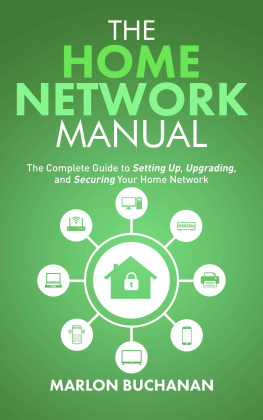Copyright 2020 All rights reserved.
It is not legal to reproduce, duplicate, or transmit any part of this document in either electronic means or in printed format. Recording of this publication is strictly prohibited and any storage of this document is not allowed unless with written permission from the publisher except for the use of brief quotations in a book review.
HomeTechHacker.com
Other books by Marlon Buchanan:
The Smart Home Manual:
How to Automate Your Home to Keep Your Family Entertained, Comfortable, and Safe
Table of Contents
Preface
Wi-Fi in our homes is no longer a luxury, its a necessity. Unfortunately, there are few things more frustrating than bad Wi-Fi connections. Who wants their streaming video to keep pausing and buffering every 5 minutes? Or to randomly drop out of Zoom calls?
You dont have to suffer from bad Wi-Fi in your home. There is a fix for almost every Wi-Fi problem and this guide aims to give you the tools and techniques you need to diagnose and fix your Wi-Fi. Just follow the steps in this book and youll be much happier with your home Wi-Fi.
Bonus Material
This is a concise, practical guide to help you with your Wi-Fi. If you are looking for more in-depth information about Wi-Fi, home networking, smart homes, and other home technology topics be sure to subscribe to HomeTechHacker.com. I regularly publish how-tos and reviews that will interest you.
Introduction
Have you noticed how important the Wi-Fi connection in your home has become? With the rise of mobile devices and the Internet of Things (IOT), your home Wi-Fi is more important than ever. Cell phones, streaming devices, smart bulbs, home security systems, washers and dryers, smart speakers, TVs, and so many other gadgets now require Wi-Fi connections to access all the geeked out features that caused you to buy them in the first place.
The significant reliance on your Wi-Fi means its important to make it fast, secure, and stable. This book will discuss the three major problems most people have with their home Wi-Fi (some of which you may not even know you have) and more importantly, detail ways to diagnose and fix these problems.
Before we start, lets define a few terms so we are all on the same page:
IoT Internet of Things. A collection of interconnected and interrelated devices that can communicate and transfer data over various networks without human interaction. It most commonly refers to the explosion of devices that are everywhere that connect to the Internet. Examples include Smart TVs, smart speakers, toys, wearables, smart appliances, and smart meters.
Wireless Access point. A wireless access point (sometimes just called an access point or an AP) connects to a router, switch, or hub via Ethernet, and projects a wireless signal to a designated area. These are used for extending a wireless network.
Router . A router forwards (or routes) packets of data between different networks. For instance, the router in your home routes packets coming from the Internet to your private home network and vice versa.
QOS Quality of Service . This refers to settings on your router that allow for the control of priority and treatment of different types of traffic (streaming, web browsing, torrenting) on your network.
Major Problem #1:
Your Wi-Fi is too slow
Is your Wi-Fi slow? Do you sometimes find yourself waiting a long time for your app to load, or an attachment to download, or for a web page to come up on your mobile phone? Do your favorite streamed shows buffer and/or stream at lower than HD quality? Lets make your Wi-Fi speed problems a thing of the past!
The root cause of your Wi-Fi slowdown can be hard to find. We are going to start with how to diagnose the major culprits and then apply a fix.
Wi-Fi Speed Culprit #1:
Your Internet connection is really slow
Symptoms:
You dont pay much for your Internet service.
Your Internet connection is really slow when multiple people are using it.
You havent properly configured your routers QOS settings.
Diagnosis:
First, find out what bandwidth you have. Go to speedtest.net from a wired computer on your home network and test your Internet speed a few times at different points in the day. Make sure no other devices are doing any significant downloading or uploading to the Internet (streaming videos, downloading large files, etc.) at the same time. Are you getting the speeds you expect based on what you purchased from your Internet service provider (ISP)?
What speed did you pay for? Do you know how much speed you need? For example, Netflix recommends 5 Mbps for each high-quality HD stream and 25 Mbps for each Ultra HD (4K) stream. Below are some common bandwidth needs for home network activities:
HD video streaming: 5-25 Mbps per stream (downloading)
Music streaming: < 1 Mbps per song (downloading)
Online gaming: 3-6 Mbps download/1-3 Mbps upload per person
Web/Social media: 3 Mbps download/1.5 Mbps upload per person
HD video call (e.g. Zoom): 1-4 Mbps upload/download per person
The amount of bandwidth your home needs depends on the number of people and their regular usage of the Internet at home. For example, lets say its common in your home for a couple of people to be streaming a video (~15 Mbps), a couple more to be browsing the web/social media (~6 Mbps) while someone is gaming online (~6 Mbps) and streaming music in the background (~1 Mbps). 15 + 6 + 6 + 1 adds up to 28 Mbps which would be the minimum download bandwidth needed to support these activities. You should always add at least 30% overhead to your calculated minimum because the speeds ISPs quote are max figures and not what they consistently give you. Also, often there are other devices on the network that are steadily using small amounts of Internet bandwidth (e.g. checking for and downloading updates).
Keep in mind that if you are frequently viewing and/or sending videos, pictures, and other files via social media your needs may be higher than the average 3 Mbps figure above. Also, there are often spikes in the rates needed by these services. For example, an online game may average 3 Mbps but may have certain spikes where it needs 10 Mbps to function properly. In the example I gave earlier Id recommend you get around 40 Mbps to cover your needs.
If you are constantly downloading content (via torrents and/or Usenet, for example) then you already know you have high bandwidth needs. It will come down to how fast you want those downloads to happen and how often you download.
Have you looked at your routers quality of service (QOS) settings? These settings can determine which types of Internet traffic and which devices have priority so that you can use your Internet bandwidth efficiently. For instance, you might want to prioritize streaming video and video chats over torrent downloads and web surfing because you would like to keep the quality of video high and eliminate buffering pauses at the expense of slowing down a web page load or file download. These are the types of scenarios you can configure with your routers QOS settings.
After walking through the steps to test your Internet speed and estimate your needs do you find you have a fast enough Internet connection? If not, this could be a major reason your Wi-Fi seems slow. You must have enough bandwidth for all the devices (not just wireless) that access the Internet. If you dont, its time to upgrade your Internet connection. You also want to make sure you have modified your routers QOS settings to prioritize the Internet traffic that is most important to you.














